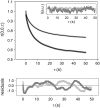Detection and correction of blinking bias in image correlation transport measurements of quantum dot tagged macromolecules
- PMID: 17526586
- PMCID: PMC1929051
- DOI: 10.1529/biophysj.107.106864
Detection and correction of blinking bias in image correlation transport measurements of quantum dot tagged macromolecules
Abstract
Semiconductor nanocrystals or quantum dots (QDs) are becoming widely used as fluorescent labels for biological applications. Here we demonstrate that fluorescence fluctuation analysis of their diffusional mobility using temporal image correlation spectroscopy is highly susceptible to systematic errors caused by fluorescence blinking of the nanoparticles. Temporal correlation analysis of fluorescence microscopy image time series of streptavidin-functionalized (CdSe)ZnS QDs freely diffusing in two dimensions shows that the correlation functions are fit well to a commonly used diffusion decay model, but the transport coefficients can have significant systematic errors in the measurements due to blinking. Image correlation measurements of the diffusing QD samples measured at different laser excitation powers and analysis of computer simulated image time series verified that the effect we observe is caused by fluorescence intermittency. We show that reciprocal space image correlation analysis can be used for mobility measurements in the presence of blinking emission because it separates the contributions of fluctuations due to photophysics from those due to transport. We also demonstrate application of the image correlation methods for measurement of the diffusion coefficient of glycosyl phosphatidylinositol-anchored proteins tagged with QDs as imaged on living fibroblasts.
Figures








Similar articles
-
A guide to accurate measurement of diffusion using fluorescence correlation techniques with blinking quantum dot nanoparticle labels.J Chem Phys. 2008 Jun 14;128(22):225105. doi: 10.1063/1.2918273. J Chem Phys. 2008. PMID: 18554062
-
Enhanced fluorescence intermittency of CdSe-ZnS quantum-dot clusters.Phys Rev Lett. 2006 Dec 8;97(23):237402. doi: 10.1103/PhysRevLett.97.237402. Epub 2006 Dec 8. Phys Rev Lett. 2006. PMID: 17280243
-
Blinking suppression in CdSe/ZnS single quantum dots by TiO2 nanoparticles.ACS Nano. 2010 Aug 24;4(8):4445-54. doi: 10.1021/nn100698u. ACS Nano. 2010. PMID: 20731430
-
[Application of novel quantum dot-based molecularly imprinted fluorescence sensor in rapid detection].Se Pu. 2021 Aug;39(8):775-780. doi: 10.3724/SP.J.1123.2021.02025. Se Pu. 2021. PMID: 34212579 Free PMC article. Review. Chinese.
-
Quantum Dot-Based Nanotools for Bioimaging, Diagnostics, and Drug Delivery.Chembiochem. 2016 Nov 17;17(22):2103-2114. doi: 10.1002/cbic.201600357. Epub 2016 Sep 21. Chembiochem. 2016. PMID: 27535363 Review.
Cited by
-
A single molecule investigation of the photostability of quantum dots.PLoS One. 2012;7(8):e44355. doi: 10.1371/journal.pone.0044355. Epub 2012 Aug 31. PLoS One. 2012. PMID: 22952963 Free PMC article.
-
Lessons in fluctuation correlation spectroscopy.Annu Rev Phys Chem. 2011;62:645-68. doi: 10.1146/annurev-physchem-032210-103424. Annu Rev Phys Chem. 2011. PMID: 21219151 Free PMC article. Review.
-
Simultaneous multi-species tracking in live cells with quantum dot conjugates.PLoS One. 2014 Jun 3;9(6):e97671. doi: 10.1371/journal.pone.0097671. eCollection 2014. PLoS One. 2014. PMID: 24892555 Free PMC article.
-
Probing cellular events, one quantum dot at a time.Nat Methods. 2010 Apr;7(4):275-85. doi: 10.1038/nmeth.1444. Epub 2010 Mar 30. Nat Methods. 2010. PMID: 20354518 Review.
-
Single-Virus Tracking: From Imaging Methodologies to Virological Applications.Chem Rev. 2020 Feb 12;120(3):1936-1979. doi: 10.1021/acs.chemrev.9b00692. Epub 2020 Jan 17. Chem Rev. 2020. PMID: 31951121 Free PMC article. Review.
References
-
- Bruchez, M. Jr., M. Moronne, P. Gin, S. Weiss, and A. P. Alivisatos. 1998. Semiconductor nanocrystals as fluorescent biological labels. Science. 281:2013–2016. - PubMed
-
- Alivisatos, P. 2004. The use of nanocrystals in biological detection. Nat. Biotechnol. 22:47–52. - PubMed
-
- Wu, X. Y., J. H. Liu, Q. J. Liu, N. K. Haley, A. J. Treadway, P. J. Larson, F. N. Ge, F. Peale, and P. M. Bruchez. 2002. Immunofluorescent labeling of cancer marker Her2 and other cellular targets with semiconductor quantum dots. Nat. Biotechnol. 21:41–46. - PubMed
-
- Pellegrino, T., L. Manna, S. Kudera, T. Liedl, D. Koktysh, L. A. Rogach, S. Keller, J. Rädler, G. Natile, and W. J. Parak. 2004. Hydrophobic nanocrystals coated with an amphiphilic polymer shell: a general route to water soluble nanocrystals. Nano Lett. 4:703–707.
-
- Gao, X., Y. Cui, M. R. Levenson, K. W. L. Chung, and S. Nie. 2004. In vivo cancer targeting and imaging with semiconductor quantum dots. Nat. Biotechnol. 22:969–976. - PubMed
Publication types
MeSH terms
Substances
Grants and funding
LinkOut - more resources
Full Text Sources
Other Literature Sources

